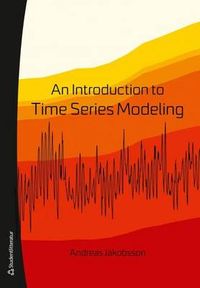
An Iintroduction to time series modeling Upplaga 1
Time series analysis concerns the mathematical modeling of time varying phenomena, e.g., ocean waves, water levels in lakes and rivers, demand for electrical power, radar signals, muscular reactions, ECG-signals, or option prices at the stock market. This book gives a comprehensive presentation of stochastic models and methods in time series analysis.
The book treats stochastic vectors and both univariate and multivariate stochastic processes, as well as how these can be used to identify suitable models for various forms of observations. Furthermore, different approaches such as least squares, the prediction error method, and maximum likelihood are treated in detail, together with results on the Cramér-Rao lower bound, dictating the theoretically possible estimation accuracy. Residual analysis and prediction of stochastic models are also treated, as well as how one may form time-varying models, including the recursive least squares and the Kalman filter. The book discusses how to implement the various methods using Matlab, and several Matlab functions and data sets are provided with the book.
The book provides an introduction to time series modeling of various forms of measurements, focusing on how such models may be identified and detailed. It has a practical approach, and include several examples illustrating the theory.
The book is aimed at advanced undergraduate and junior graduate students in statistics, mathematics, or engineering. Helpful prerequisites include courses in multivariate analysis, linear systems, basic probability, and stochastic processes.
Upplaga: 1a upplagan
Utgiven: 2013
ISBN: 9789144083742
Förlag: Studentlitteratur AB
Format: Häftad
Språk: Engelska
Sidor: 366 st
Time series analysis concerns the mathematical modeling of time varying phenomena, e.g., ocean waves, water levels in lakes and rivers, demand for electrical power, radar signals, muscular reactions, ECG-signals, or option prices at the stock market. This book gives a comprehensive presentation of stochastic models and methods in time series analysis.
The book treats stochastic vectors and both univariate and multivariate stochastic processes, as well as how these can be used to identify suitable models for various forms of observations. Furthermore, different approaches such as least squares, the prediction error method, and maximum likelihood are treated in detail, together with results on the Cramér-Rao lower bound, dictating the theoretically possible estimation accuracy. Residual analysis and prediction of stochastic models are also treated, as well as how one may form time-varying models, including the recursive least squares and the Kalman filter. The book discusses how to implement the various methods using Matlab, and several Matlab functions and data sets are provided with the book.
The book provides an introduction to time series modeling of various forms of measurements, focusing on how such models may be identified and detailed. It has a practical approach, and include several examples illustrating the theory.
The book is aimed at advanced undergraduate and junior graduate students in statistics, mathematics, or engineering. Helpful prerequisites include courses in multivariate analysis, linear systems, basic probability, and stochastic processes.
Begagnad bok (0 st)
Varje vecka tillkommer tusentals nya säljare. Bevaka boken så får du meddelande när den finns tillgänglig igen.



